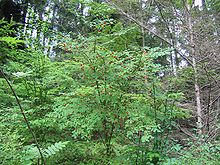Vaccinium parvifolium
| Vaccinium parvifolium | |
|---|---|
 |
|
| Scientific classification | |
| Kingdom: | Plantae |
| (unranked): | Angiosperms |
| (unranked): | Eudicots |
| (unranked): | Asterids |
| Order: | Ericales |
| Family: | Ericaceae |
| Genus: | Vaccinium |
| Species: | V. parvifolium |
| Binomial name | |
|
Vaccinium parvifolium Sm. |
|
Vaccinium parvifolium, the red huckleberry, is a species of Vaccinium native to western North America, where it is common in forests from southeastern Alaska and British Columbia south through western Washington and Oregon to central California.
In the Oregon Coast Range, it is the most common Vaccinium. It occurs mostly at low to middle elevations in soil enriched by decaying wood and on rotten logs, from sea level up to 1,820-metre (6,000 ft).
It is a deciduous shrub growing to 4-metre (13 ft) tall with bright green shoots with an angular cross-section. The leaves are ovate to oblong-elliptic, 9-millimetre (0.35 in) to 30-millimetre (1.2 in) long, and 4-millimetre (0.16 in) to 16-millimetre (0.63 in) wide, with an entire margin.
The flowers are yellow-white to pinkish-white with pink, decumbent bell-shaped 4-millimetre (0.16 in) to 5-millimetre (0.20 in) long.
The fruit is an edible red to orange berry 6-millimetre (0.24 in) to 10-millimetre (0.39 in) in diameter.
Newly opened leaves
Blossoms
Blossoms
Leaves and fruit
Indigenous peoples of North America found the plant and its fruit very useful. The bright red, acidic berries were used extensively for food throughout the year. Fresh berries were eaten in large quantities, or used for fish bait because of the slight resemblance to salmon eggs. Berries were also dried for later use. Dried berries were stewed and made into sauces, or mixed with salmon roe and oil to eat at winter feasts.
The bark or leaves of the plant were brewed for a bitter cold remedy, made as tea or smoked. The branches were used as brooms, and the twigs were used to fasten western skunk cabbage leaves into berry baskets.
...
Wikipedia
